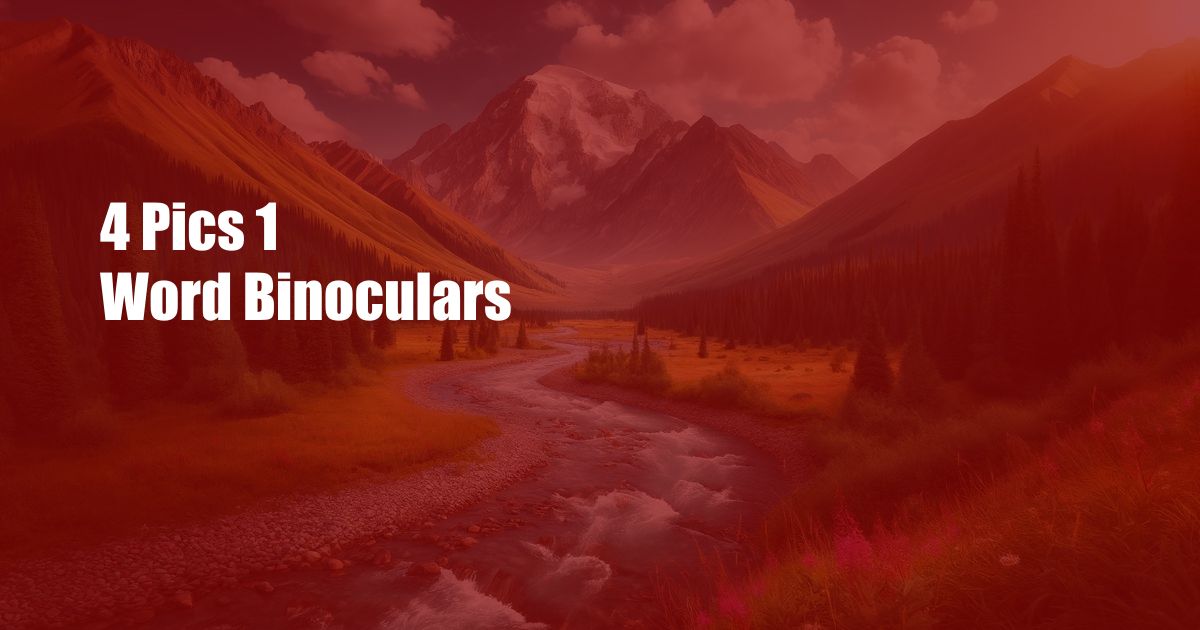
4 Pics 1 Word: Binoculars
In the realm of word games, 4 Pics 1 Word stands as a captivating enigma, challenging players to decipher a single elusive word based on a quartet of seemingly unrelated images. The game has garnered an ardent following worldwide, enticing minds of all ages with its addictive gameplay and perplexing puzzles.
One particularly intriguing puzzle features a series of images that, at first glance, appear disconnected: a pair of eyes, a bird’s eye view of a city, a group of people looking up, and a magnifying glass. Yet, as the cogs of deduction begin to turn, a connection emerges, leading us to the enigmatic answer: binoculars.
The Enigmatic Power of Binoculars
Binoculars, an indispensable tool for explorers, birdwatchers, and nature enthusiasts alike, offer a tantalizing glimpse into distant worlds. These optical marvels extend our visual range, bringing distant objects closer, revealing details that would otherwise remain hidden.
Their unique design, consisting of two parallel telescopes aligned side by side, provides a stereoscopic view, enhancing depth perception and creating a sense of immersion. This remarkable ability to magnify objects and provide a three-dimensional perspective has made binoculars an essential equipment for a wide range of activities, from wildlife observation to stargazing.
The History and Evolution of Binoculars
The genesis of binoculars can be traced back to the early 17th century, when Dutch spectacle makers Hans Lipperhey and Zacharias Janssen independently invented the first telescopes. These early devices were bulky and cumbersome, but they laid the foundation for the development of more compact and portable binoculars.
Over the centuries, binoculars underwent a series of refinements and innovations. In the 19th century, the Porro prism design revolutionized binocular technology, allowing for a more compact and ergonomic design. Further advancements in lens technology and optical coatings enhanced image clarity and reduced distortion, leading to the development of high-performance binoculars that we know today.
The Science Behind Binoculars
Binoculars operate on the principles of reflection and refraction. Light from a distant object enters the objective lenses, which are typically large in diameter to gather as much light as possible. This light is then reflected by a series of prisms or mirrors, depending on the binocular design, to the eyepieces.
The eyepieces, which are smaller than the objective lenses, magnify the image formed by the objective lenses, creating a virtual image that appears closer to the observer. The distance between the objective and eyepiece lenses determines the magnification power of the binoculars, expressed as a ratio, such as 8x or 10x.
Choosing the Right Binoculars
With a multitude of binoculars available on the market, selecting the perfect pair can be a daunting task. Factors to consider include magnification, objective lens diameter, close focus, and field of view.
Magnification determines how much an object is enlarged, while objective lens diameter affects light-gathering capabilities and image brightness. Close focus refers to the minimum distance at which an object can be clearly seen, while field of view indicates the width of the area visible through the binoculars.
Expert Tips for Binocular Use
To fully appreciate the wonders of binoculars, it’s essential to use them properly. Here are a few expert tips to enhance your viewing experience:
- Hold binoculars steady: Use both hands and rest your elbows against your body for maximum stability.
- Adjust interpupillary distance: The distance between the eyepieces should match the distance between your eyes for optimal viewing.
- Focus gradually: Start by focusing on a distant object and gradually adjust the focus until the image becomes sharp.
- Keep lenses clean: Regularly clean the lenses with a soft, microfiber cloth to remove dirt and smudges.
- Store binoculars properly: Keep your binoculars in a protective case when not in use to prevent damage.
By following these simple tips, you can unlock the full potential of your binoculars and embark on breathtaking adventures, discovering the hidden wonders that lie just beyond your sight.
FAQs on Binoculars
- Q: What is the difference between binoculars and a telescope?
A: Binoculars have two eyepieces for stereoscopic viewing, while telescopes have a single eyepiece and provide a higher magnification. - Q: What magnification is best for birdwatching?
A: Magnifications between 8x and 10x are ideal for birdwatching, offering a good balance of magnification and field of view. - Q: How do I clean my binoculars?
A: Use a soft, microfiber cloth to gently wipe the lenses. Avoid using harsh chemicals or abrasive materials. - Q: What is the best way to store binoculars?
A: Keep your binoculars in a protective case in a dry and dust-free environment. - Q: What are the benefits of using binoculars?
A: Binoculars enhance visual range, provide stereoscopic viewing, and allow for detailed observation of distant objects.
Conclusion
4 Pics 1 Word has once again captivated our minds, leading us on a thrilling quest to uncover the enigmatic word hidden within its enigmatic images. The answer, binoculars, unveils the wonders of these optical marvels, empowering us to explore distant worlds and bring them closer.
Whether you’re an avid birdwatcher, a curious explorer, or simply seek to expand your horizons, binoculars offer a window into a realm of hidden wonders. Embrace their ability to magnify the unseen, unlocking the secrets of nature and enriching your adventures with every use.
Are you intrigued by the world of binoculars and the captivating puzzles of 4 Pics 1 Word? Share your experiences, insights, and favorite binocular moments in the comments below.
 Azdikamal.com Trusted Information and Education News Media
Azdikamal.com Trusted Information and Education News Media